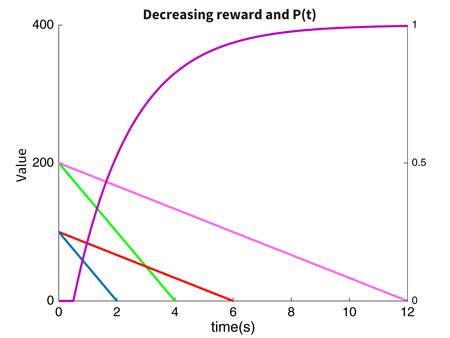 |
 |
How do people trade off information against time? |

Introduction |
In many decisions we face, collecting information about the options under consideration is instrumental to making good choices. In theory, gathering more information can never hurt. However, information collection often comes with a cost – it takes time and effort to do so. How do people balance between the gain that more information brings and the cost of time and energy that comes with it? To address this question, we designed a novel visuo-motor decision task where the gain of information and cost of time are dynamically manipulated. We investigated how humans make timing decisions by trading off the benefit of time, such as taking time to collect more information for an increase in the chance of success, against the cost of time, under different dynamics of cost structure. In a visuo-motor task, subjects had to point to a hidden target presented on a touch screen for a chance to receive a small monetary reward. Noisy visual information about target location was presented in the form of dots sampled from a bivariate Gaussian distribution around the target center. Critically, the number of dots presented increased as a function of time so that the longer the subjects waited, the larger the sample size and hence the higher the probability of hitting the hidden target. However, upon dots presentation, the amount of reward for a hit started to decrease so that the longer the subjects waited before initiating his/her movement, the smaller the reward s/he would receive if successfully hitting the target. We manipulated both how fast the reward decreased over time (reward decreasing rate) and the amount of reward to start with (starting value).
|
 |
_2.jpg) |
Procedure |
Overview on the main task In this experiment, we designed a visual-motor task to study how humans make timing decisions by actively trading off information against time. There are 3 design principles for introducing such tradeoff to the subjects. First, more information is associated with better performance and greater chance of receiving a reward. Second, information accumulates over time so that taking more time leads to a greater chance of reward. Third, the amount of reward for good performance decreases over time. This is effectively implementing a cost function for time. Together, these 3 principles presented a serious decision problem to the subjects: Should the subjects go and make a response too fast, she or he risks the probability of not earning a bigger reward. On the other hand, if she or he waits for information to accumulate, she faces a high likelihood of winning a small reward. The question for the subject is: when is the best timing to make a response? Based on these 3 principles, we designed the main task of the experiment in Session 4 to address the tradeoff problem. In order to evaluate subjects’ performance, we designed a series of tasks to rule out potential confounds related to learning and practice effects. The resulting experiment thus consisted of 4 experimental sessions that spanned over 2 to 3 days. |

Session 1 The goal of this session was to train the subjects to perform the motor aspect of the main task. As the video shows, the subjects were instructed to hit a small target – a white dot– presented on a touch screen. In this way, we could estimate the motor ability of every subjects. |

Session 2 Following the first design principle, we want to let the subjects learn how to use partial information to hit a hidden target and there are three different quantity level of information. The dots contained information about target location because they were sampled from a bivariate Gaussian distribution around the target center. |

Session 3 In this session, we followed the second principle to investigate how performance (probability of hitting the target) changed as a function of time and to estimate the speed-accuracy tradeoff (SAT). Importantly, unlike in Session 2 where dots were presented simultaneously, in this session the dots were presented sequentially. |

Session 4 This session is the main focus of the experiment. We constructed this session by combing all three design principles. As in Session 3, the dots (information about target location) were presented sequentially. What is different in this session is the reward dynamics. Unlike in Session 3 where the reward for hitting the target was fixed, in this session the amount of reward for hitting the target decreased over time. |

| Back to Top |